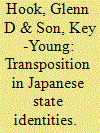| Srl | Item |
| 1 |
ID:
144304


|
|
|
|
|
| Summary/Abstract |
The rise of nationalism, unresolved territorial disputes, an intricate system of alliances, and the perceived breakdown of the balance of power have been identified as the main causes behind the outbreak of World War I. They also are strikingly similar to the challenges East Asia faces today. Will history repeat itself and see East Asia sleepwalking into another hegemonic war? China's future relations with the United States and Japan will be crucial for East Asia's regional order, but its dispute with Japan over the Senkaku/Diaoyu Islands might lead to a regional war. I argue, however, that a major war is unlikely because pre–World War I Europe and today's Northeast Asia are qualitatively different in terms of what I call multihegemony and sutured regionness.
|
|
|
|
|
|
|
|
|
|
|
|
|
|
|
|
| 2 |
ID:
119067


|
|
|
|
|
| Publication |
2013.
|
| Summary/Abstract |
This article aims to illustrate the trajectory of Japan's security identity transposition. As one of the catalysts in identity transposition, it focuses on the constitutive roles of norms regulating Japan's overseas dispatches of the Self-Defense Forces (SDF). Whilst keeping the identities of 'a peace state' and 'a civilian power', the authors argue that Japan has crafted a new security identity after the end of the cold war and the 9/11 terrorist attacks-namely, 'an international humanitarian power'. As evidence of this transposition, the authors illustrate a dramatic increase in the number of overseas SDF dispatches on humanitarian missions, and the shift of domestic and foreign responses to it. The authors note that Japan has been on the road to remilitarisation and internationalisation during the past four decades through the enactments of laws for overseas SDF dispatches, the general public's shift of attitude on the SDF's roles, the evolution of the alliance in a more operational direction, and the creation of threats from North Korea and China. Lastly, the authors argue that there is still a long way to go before Japan emerges as a normal state because of the presence of many domestic and structural barriers, especially multiple identities defining the Japanese state.
|
|
|
|
|
|
|
|
|
|
|
|
|
|
|
|